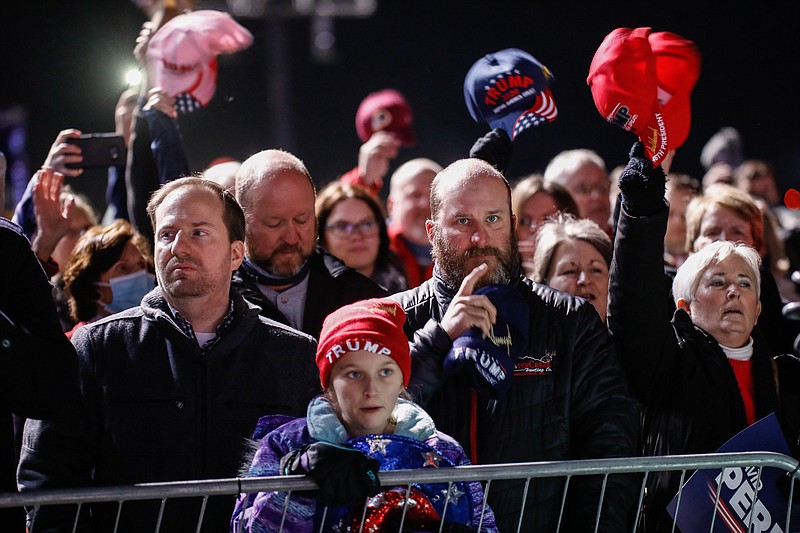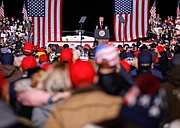When President Trump visited Dalton on the eve of one of Georgia's most consequential elections in state history, he was doing so in a county dealing with one of the state's worst COVID-19 outbreaks during one of the worst health pandemics in history.
More than a week after Trump visited and as thousands of his supporters from all over the region swarmed the tarmac at the Dalton Municipal Airport, cases have spiked once again in Whitfield County. Those case rates match up almost identically to a study that looked at how Trump rallies nationwide have been followed by higher caseloads where they are held.
In October 2020, a group of economists from Stanford University created a statistical model that estimated how many cases and related deaths stemmed from Trump's rallies held between June and September.
The study concluded there have been at least 30,000 coronavirus infections and 700 deaths as a result of 18 campaign rallies that Trump held in those four months.
Professor B. Douglas Bernheim, chairman of the university's economics department, led the group.
For its data, the group compared the 18 counties where Trump held rallies with at least 200 counties with similar demographics and similar trajectories of confirmed COVID-19 cases before the Trump rally date. The findings are not based on individual cases traced directly to a particular campaign event.
Two of the rallies in June - one in Tulsa, Oklahoma, and the other in Phoenix - were held indoors.
The research found that, on average after one of Trump's rallies, coronavirus cases increased by 250 new cases per 100,000 residents "over roughly the ensuing two months," Bernheim said.
"The effects mainly emerge after the first two weeks, which is not surprising given that community spread takes time," Bernheim said in an email Thursday.
The study found the rallies had "likely led to more than 700 deaths," though the deaths would not necessarily have occurred among the attendees but through community spread.
On Jan. 1 - three days before Trump would visit Dalton - Whitfield County had reported 1,118 new cases over the previous 14 days per 100,000 people, one of the highest numbers in the state.
Using the Stanford paper's estimates, that would mean Whitfield County could see about 1,378 new cases per 100,000 residents over the next two months, with an expected majority of those cases coming in the ensuing 14 days.
Only 10 days later, on Thursday, Whitfield County has reported 1,426 new cases per 100,000 residents over the past two weeks, surpassing even the research paper's expected increase in cases.
The county also has hit a record high for new cases per day per 100,000 people on a seven-day average with 125.3, three days after the Whitfield County Commission voted to repeal a mask mandate for county buildings.
Bernheim was quick to point out that the study did not include data from Trump's fall rallies, which is an important caveat.
"Their effects may have differed from those of the earlier rallies," he said. "There are some indications that compliance with mask guidelines increased at Trump rallies during the fall."
Bernheim explained that while Trump's message surrounding COVID-19 changed as the pandemic wore on, so did his supporters' behavior.
"Simply put, when the President arrives in a county and tells his supporters that X is true, they tend to accept X," he said. "This effect was presumably larger when attitudes toward COVID were still in flux; by fall, it's possible they had largely hardened."
Then again, he said, "higher baseline COVID rates during the fall may have led to higher impact."
Sherry Gregory, the infectious disease director with the North Georgia Health District, told the Times Free Press that her office has been completely swamped due to the continued rise in COVID-19 infections and the rollout of the vaccine.
"I was not at the rally nor did I watch any news programs referencing it, but as in any event where large crowds gather, the potential for increased spread is great," Gregory said by email. "Not having seen the crowds, I cannot comment whether people were masked or social distanced, etc. However, we do want to remind the public to avoid large crowds - or even a smaller gathering of people you donot live with, maintain social distancing from others, always wear a mask when in public places, wash hands often or use hand sanitizer and keep surfaces disinfected."
The Times Free Press spoke to about a dozen people at the rally, most of whom were not wearing masks. Several of the attendees were from out of state from places such as Tennessee, South Carolina, North Carolina and Alabama.
Thousands of people attended the rally and many did not wear masks, although the event's organizers encouraged them. The risk of spreading the virus outdoors is lower than indoors, but with the grandstands packed for Trump's arrival, it was hard to socially distance for those with a seat.
Hundreds - if not thousands - of other attendees stood around the event stage where social distancing was slightly easier.
Bernheim said Thursday he would be careful about making any strong statements about the effects for the fall rallies, given the variables.
"We are in the process of updating our paper with some additional analysis and may eventually be able to shed more light on the question," he said.
At the Jan. 4 rally, Trump was stumping for Republican candidates David Perdue and Kelly Loeffler in a runoff election for Georgia's two seats in the U.S. Senate. Both candidates lost. At the rally, Trump touted his unsuccessful effort to get pandemic relief checks for Americans increased from the $600 approved by Congress to the $2,000 he favored.
"My reasoning is simple," he told the crowd. "I mean, we're conservative with money, but my reasoning is simple. You didn't cause this problem. This problem was caused by China."
Contact Patrick Filbin at pfilbin@timesfreepress.com or 423-757-6476. Follow him on Twitter @PatrickFilbin.
Read the PATCHWORK PANDEMIC project from the Times Free Press:
How politics and personal choice fueled the Chattanooga region's COVID-19 crisis
How Whitfield County became one of Georgia's worst COVID-19 hot spots

